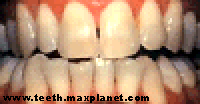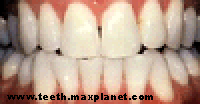CONTENTS:
What are the causes for discolouration of teeth?
What are the treatments for discoloured teeth?
Who are suitable for tooth bleaching?
How is tooth bleaching done?
What is the chemical used for bleaching?
What are the complications seen in tooth bleaching?
Individuals who have discoloured teeth and are not satisfied with the appearance of their teeth, go to great lengths to achieve the perfect smile. Brushing, flossing and regular professional cleaning help by removing the stains and deposits on the surface of the teeth. But for those patients who have dark, yellow, brown or other discoloured teeth, there has never been a simple solution. Ever since the invention of the mirrors, people have been looking for an easy way to have whiter teeth.
What are the causes for discolouration
of teeth?
Discolouration of teeth can be broadly classified into two types:
What are the treatments for
dicoloured teeth?
Different discolouration require different solutions and therefore
it is important to have a consultation with a dentist before starting any
form of treatment. Most of the extrinsic stains can be removed by simple
professional cleaning (Scaling).
Tooth bleaching can be a solution
to achieve whiter teeth. This can be done by a dentist in the dental clinic
or by the individual at home. The most effective and safest method of tooth
bleaching is dentist supervised. Teeth darkened with the color of yellow,
brown or orange respond better to bleaching. Bleaching can only provide
a shift in color to a lighter shade.
Ceramic (Porcelain) crowns can
be used if only a few teeth are involved. This can be the best solution
for RCT treated teeth.
Composite Veneering: Composites
are special type of tooth coloured resins that can be bonded to the tooth.
The thickness of the tooth is reduced and the stains are masked with the
help of special opaquers. The required shade of composite material is then
veneered and bonded to the tooth.
Porcelain Veneering: These are
translucent ultra-thin layer of ceramic material, which are bonded to the
front of teeth with the help of dental cements or composites. Porcelain
veneers are an excellent alternative to crowns, and in many situations
for teeth stained by tetracycline. They provide a much more conservative
approach to changing a tooth's colour, size or shape, than a crown. The
thickness of the teeth is reduced and an impression made of the mouth.
The translucent porcelain veneer is fabricated in a dental lab. On the
next visit the veneers are placed on the teeth and the shade of the bonding
cement to be used is selected. Then the wafer thin translucent porcelain
veneer is bonded to the tooth surface with the help of the selected bonding
cement or composite. Porcelain veneers are reasonable facsimiles of natural
teeth but may not be the perfect replacements.
Who are suitable for tooth bleaching?
Tooth bleaching can be used to achieve whiter teeth. There are many
home bleaching kits available in the market. But any person considering
using home bleaching products should seek advice from a dentist before
starting. This is crucial as home-bleaching treatments may not be effective
or preferable for every individual. If you have sensitive teeth, periodontal
disease, or teeth with worn enamel (abrasion or attrition), your dentist
may discourage bleaching. For the best and safest results the individual
should be monitored by the dentist throughout the home bleaching process.
Teeth darkened with the color of yellow, brown or orange respond better
to bleaching. Other types of gray stains caused by fluorosis, smoking or
tetracycline are lightened, but results are not as dramatic.
Tooth bleaching safely lightens the colour of the teeth. Bleaching
should last for one to five years, depending on your personal habits such
as smoking, drinking black coffee or tea, pan chewing, oral hygiene, etc.


How is tooth bleaching done?
The dentist will make impressions of your teeth to fabricate a custom-fitted
tray for you. The tray is lightweight and thin so that it can be worn comfortably
while you are awake or asleep. You would even be able to talk and work
while wearing it. Along with the custom-fitted tray you’ll receive the
bleaching materials. You'll be given instructions on how to wear the tray
and use the bleaching materials.
Some bleaching systems recommend bleaching your teeth for two to
four hours a day. Generally this type of system requires three to six weeks
to complete and works best on patients with sensitive teeth. Other systems
recommend bleaching at night while you sleep. This type of system usually
requires 10-14 days to complete.
If you're in a hurry for whiter teeth, you may decide to have your
teeth bleached using an in-office bleaching system. A single tooth or a
set of teeth is bleached with a very high concentration of bleaching material.
For this you have to visit the dentist regularly for a few days. After
a root canal, that tooth may be lightened to match the surrounding teeth
with this method. This is also referred to as walking beach when used on
a non-vital (dead) tooth. But this has the higher risk of producing sensitive
teeth when used on vital teeth. In-office whitening combined with a take-home
whitening kit is an effective way to remove tetracycline stains.


What is the chemical used for bleaching?
The active ingredient in most of the whitening (bleaching) agents
is 5 – 20% carbamide peroxide (CH4N2O2). When water comes in contact with
these white crystals it releases hydrogen peroxide. This makes the outer
enamel of the teeth more opaque resulting in a whiter teeth. Sometimes
lasers are used to activate the bleaching process during in-office bleaching.
What are the complications seen in tooth bleaching?
A small number of people may experience temporary discomfort during
the bleaching treatment, such as gum or tooth sensitivity. These symptoms
disappear within one to three days after completion of the treatment. It
is important that the manufacturer’s directions are followed precisely
if home treatment kits are used.
Sometimes the biting edges and the sides of the tooth whiten more quickly than the rest of the tooth. This occurs because your enamel is thinner in these areas and responds faster to the bleaching process. As you continue to use the teeth-whitening system, the rest of your tooth surface will catch up and the colour will even out.
No one can really predict how much lighter your teeth will become after bleaching. Every case is different. Usually there is a two-shade improvement, as seen on the dentist's shade guide. The success rate depends upon the type of stain involved and your compliance. Bleaching can only provide a shift in color to a lighter shade.
Bleaching does not lighten artificial materials such as composites glassinomer or silicate fillings, resins, or porcelains. If you any such dental work in your mouth then after the bleaching process you will have to redo them to the “newer” shade of your teeth.
* My Homepage * Know your teeth * Know your Gums (Gingiva) * Eruption Dates * Six Golden Rules * Brushing\Flossing Technique * Wisdom tooth * Tooth Decay * Extraction * Dental Implant * Surgical Extraction * Orthognathic Surgery * Asymmetry of the face * Gummy Smile * Prognathism{Long Jaw} * Beggs\Straight wire{Orthodontia} * Bleaching{Tooth Whitening} * Habit Breaking Appliances * Interceptive Orthodontics * Discolouration\Veneers * Composite\Amalgam Fillings * Root Canal Treatment{RCT} * Crown{Porcelain\Castmetal} * Flap Surgery/Splinting * Bridges{Porcelain\Castmetal} * TMJ (Joint) Disorders * Bell's Palsy {Facial Paralysis} * Ankylosis{Difficulty in mouth opening} * Cleft Lip and Palate * Trigeminal Neuralgia * In a Lighter vein

updated Aug2002.